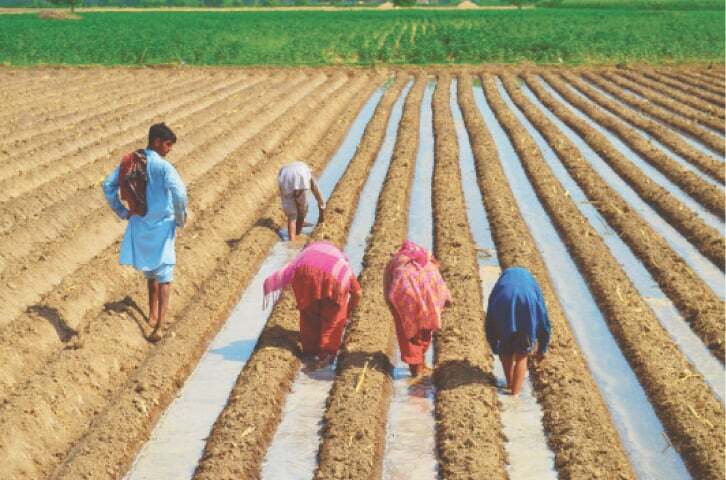Tags
Woes of female farmers

Farmers planting corn seeds in Punjab.
Female farmers are the strongest link in the agriculture sector, providing 70 per cent of labour. Paradoxically, they are also the weakest link because their contribution to the sector is neither documented nor accounted for: they are treated more like informal and private help rather than formal labour in the traditional and legal sense. They are the unsung heroines!
However, this missing measurement of their contribution is just a tiny part of the problems that they face in the field. Researchers put female farmers in three broad categories: land owners, workers on family farms, and landless labourers. Those belonging to the first category are a tiny minority, inheritors of some ancestral land or widowers looking after land after their husband if their kids are too small to do it or studying in the cities.
The second group is the largest, including those working on their own small holdings and helping their sons or husbands in the fields. The third comprises around 40pc landless farmer families living in rural or city-suburban areas. When one talks about the problems of female farmers, they normally fall into one of the last two groups.
In the first instance, the inheritors of land are mostly absentee landlords for two reasons: they lack the skill to manage fields and rates of leasing out land. “These daughters of big landlords are never exposed to agricultural practices; they prefer tenants and avoid hassles.
Rural women spend more time caring for livestock than their own children
“Since lease rates have increased substantially due to the introduction of cash crops and three crops a year cycle, most of them lease out their land and get a yearly fixed amount. Because such farmers are less than even 1pc, they hardly count in overall agricultural realities,” says Samina Agha of the Vehari area.
In the second category, the overwhelming majority (more than 90pc) of farming families belonging to this class engage their women in agricultural practices because their land holdings are too small to afford outside employment. “Since women’s participation here is a complex whole of traditional socio-cultural factors, they neither complain of exploitation nor insist on quantifying their contribution,” says Bushra Khaliq, an activist for women’s rights.
It is the last class, comprising roughly 40pc of landless families that provide most of the female workers. This class has been part of studies by researchers and non-governmental organisations due to their consistent complaints of exploitation of all sorts and yearning for legal cover for labour.
Activists list overlapping problems between these two groups. They say that since the entire arrangement between farmers and female workers is informal, there are neither fixed working hours nor wages for labour.
The labour is seasonal (based on crop and weather conditions), it neither comes regularly nor in the same quantity. Nothing here is indentured; it is always open to exploitation after the event, and it is done regularly and severely.
Explaining the context of the problems, Sumaira Ishfaq — a social development expert — says that women’s participation in fields is defined by their characteristic of femininity. Their know-how of farming is less than that of their male counterparts (because they have never been trained), which minimises their output and, thus, wages. They are seldom involved in managing heavy machinery and hard physical activities.
All these factors become sources of exploitation to reduce their reward. This is despite the fact that none of these factors are women’s own making. No government agency trains them in crops or machinery, but they face the brunt, Ms Ishfaq regrets.
Take it a step forward and imagine all this exploitation happening in a legal vacuum, laments Akeela Naz, who has been involved in female farming issues for the last two decades.
In the caretaker setup, Sindh has initiated the process of providing legal cover to women on the field. However, Punjab — a proud owner of 80pc of national agriculture — is still to start one. “We hope that the first female chief minister of the Punjab will spare some time and look into this issue,” she wishes.
“As far as livestock, which now accounts for 62pc of the agriculture sector, women’s participation is well over 90pc. As they say, rural women spend more time caring for livestock than their own children. Livestock rearing and poultry are completely female fields. But still, their knowledge of both is indigenous and lacks modern dimensions. All this needs to be updated through training,” demands Bismillah Iram.
Dr Iqrar Ahmad Khan, Vice Chancellor of Agriculture University Faisalabad, suggests that nothing would happen in isolation. The government needs to return to strengthening home sciences subjects at school and college level, which hones girls’ skills in basic subjects like kitchen gardening, dairy development, and basic agriculture.
They should induct female officers into their Extension Service dedicated to female training. Unless it is done, expanding farm mechanisation would quickly exclude even these untrained female workers and create chaos in rural Pakistan.
Published in Dawn, The Business and Finance Weekly, March 11th, 2024
https://www.dawn.com/news/1820707/woes-of-female-farmersPublished Date: March 11, 2024






